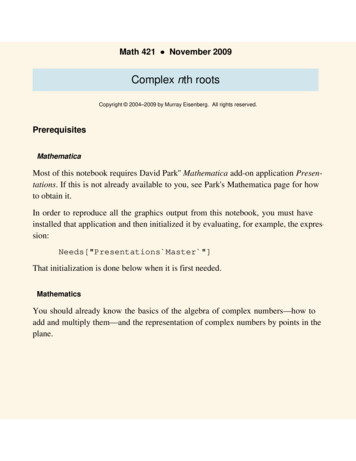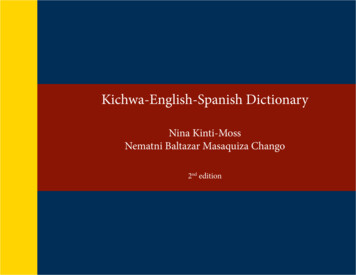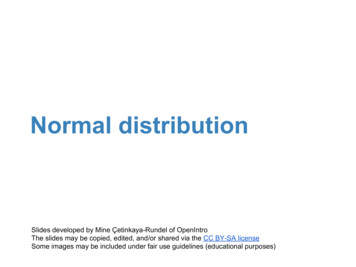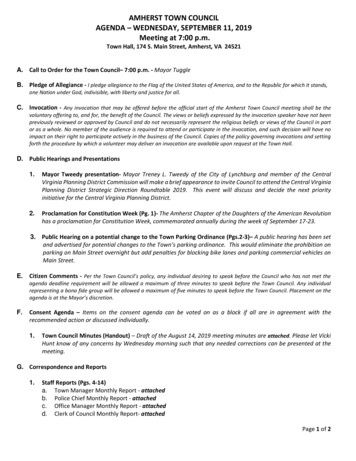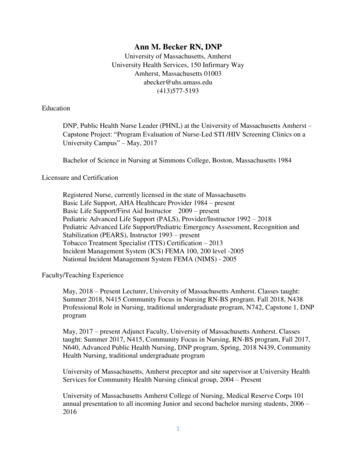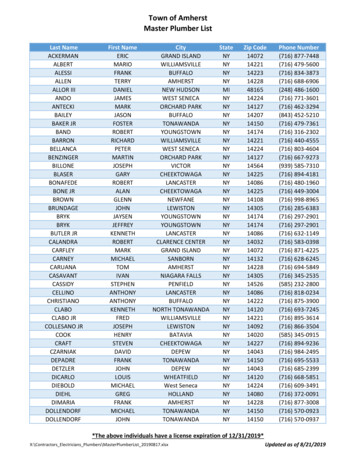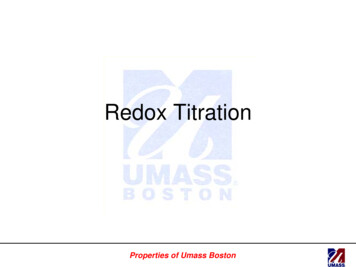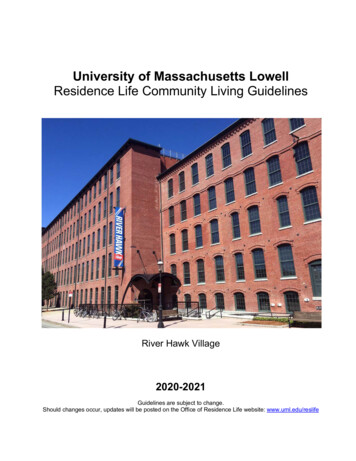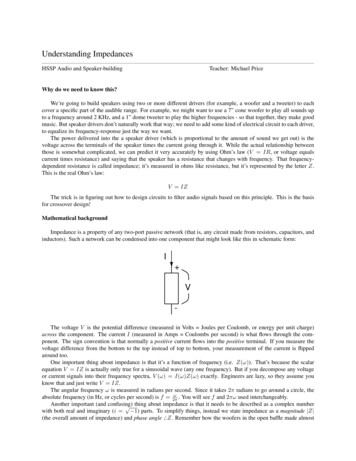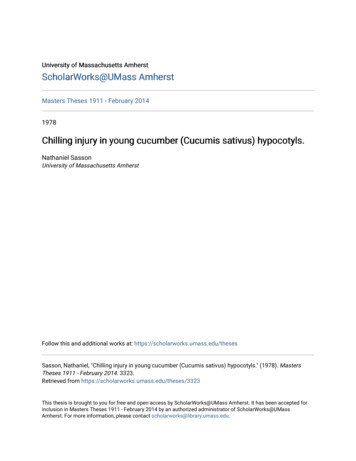
Transcription
University of Massachusetts AmherstScholarWorks@UMass AmherstMasters Theses 1911 - February 20141978Chilling injury in young cucumber (Cucumis sativus) hypocotyls.Nathaniel SassonUniversity of Massachusetts AmherstFollow this and additional works at: https://scholarworks.umass.edu/thesesSasson, Nathaniel, "Chilling injury in young cucumber (Cucumis sativus) hypocotyls." (1978). MastersTheses 1911 - February 2014. 3323.Retrieved from https://scholarworks.umass.edu/theses/3323This thesis is brought to you for free and open access by ScholarWorks@UMass Amherst. It has been accepted forinclusion in Masters Theses 1911 - February 2014 by an authorized administrator of ScholarWorks@UMassAmherst. For more information, please contact scholarworks@library.umass.edu.
CHILLING INJURY IN YOUNG CUCUMBER (Cucumis sativus) HYPOCOTYLSA Thesis PresentedByNATHANIEL SASSONSubmitted to the Graduate School o'f theUniversity of Massachusetts in partial fulfillmentof the requirements for the degree ofMASTER OF SCIENCESeptember1978Plant and Soil Science
1CHILLING INJURY IN YOUNG CUCUMBER (Cucumis sativns) HYPOCOTYLSA Thesis PresentedByNATHANIEL SASSONApproved as to style and content by:''7//- i y //J LX O fGLulFill i amBrazil age , Chairperso i of-XU.Committee/Vl;'Paul H.Jepliings,emberHerbert V. Harsh, MembervAllen V. barker, Department Headllant and Soil Sciences
PREFACEI would like to thank Dr. W.J. Bramlage for his insightand guidance during the formulation of this thesis,andfor his excellent critical comments during the draftingof this paper.I am grateful to Dr. P.H. Jennings foralways being around when needed, with enough energy tosolve the impossible problems.I am appreciative ofthe inspiration Dr. H.V. Marsh gave me during my firstyear in Amherst, and for his healthy skepticism of anyresearch proposal.
IABSTRACTChilling of 8-day-old Cucumis sativus seedlings for48 hr at 2 C caused reversible damage; chilled seedlingscollapsed but regained turgor within 6 hr at 25 C.Hypocotylsegments from the chilled seedlings exhibited greater soluteleakage at removal from chilling,and increasedproduc tion and Op uptake 2 to 3 hr after transfer to 25 C.treatment of seedlings before chilling with 10to a lesser extent pretreatment with 10-4Pre-M ABA, andM CaC -j reducedchilling injury and solute leakage, while pretreatment with10 M ascorbate increased chilling damage.These effectsof ABA and CaCl are consistent with the phase-changeconcept of chilling injury.Op uptake by hypocotyl segmentsincreased during the first 6 hr of seedling recovery at 25 C,but returned to the rate of uptake by unchilled seedlings by24 hr at 25 C.Chilled tissue was sensitive .to 2,4 DNPduring this period of accelerated Op uptake.Whereas un chilled tissue was insensitive to 10 M SHAM, chilled tissuewas sensitive to SHAM inhibition of Op uptake during theburst of Op uptake, but not subsequent to the burst of Opuptake.A possible role of CN-insensitive respiration in therecovery from chilling injury is discussed.IV
TABLE OE CONTENTSTitle.iPreface.ii.iiAbstractTable of Contents.List of Tables and Figuresiv.vIntroduction .1Literature Review .5Chapter IChapter IIChapter IIIMaterials and Methods.18.18Determinations of Solute Leakage19Respiration.20Ethylene Determinations.21.23Chilling Injury .23Ethylene Production .26Respiration .26Plant MaterialChapter IVResultsChapter VDiscussion .33Literature Cited37Chapter VIChapter VIIAppendixhiV
LIST OF TABLES AND FIGURESTable1.Effect of chilling time on solute leakage fromCucumis hypocotyls2.24Effects of treatment applied before chilling onsolute leakage from Cucumis hypocotyls after48 hr chilling at 2 C .3.Effect of chilling on ethylene production byCucumis hypocotyls .4.27Effect of SHALL and 2,4 DNP on oxygen consumptionof 8, 9 or 10 day old Cucumis hypocotyls .5.2528Effect of 10-4M, 2,4 DNP or 10 4M SHAM on oxygenconsumption of Cucumis hypocotyls, with orwithout pretreatment with 10ABA beforechilling for 48 hr at 2 C .6.50Effect of chilling at 2 C, 99 5% RH for 48 hron solute leakage from Cucumis hypocotyls,as determined by OD qq or conductivity bymethods described in Table 17.(n 10).44Effects of different concentrations of 2,4 DNP,KCN or SHALI on oxygen consumption of Cucumishypocotyls, as determined by methods describedin Table 4.8. 5Effect of various sprays on solute leakage fromnon-chilled Cucumis hypocotyls, as determinedby 0D g0 or conductivity by methods describedin Table 1.Figure1.Changes in respiration of Cucumis hypocotyls duringrecovery at 25 C, 85% HH following 48 hrat 2C .vi46
C H A P T E RIINTRODUCTIONPost-imbibitional chilling injury may occur in manycrops following early spring planting.Injury can beexpressed as decreased vigor and yield and increased sus ceptibility to pathogens.The magnitude of injury is afunction of both duration of exposure and chilling tempera ture, with sensitive plants usually injured below 12 C.The primary response to chilling temperatures insensitive plants is believed to be a phase-change in cellmembranes, causing an imbalance of metabolism as compartalization of the cell is disrupted (41,42).Cellularcomponents may not all be affected simultaneously andmitochondrial membranes undergo a phase transition at ahigher temperature than plasma membranes (47); furthermore,the tonoplast is reportedly the first membrane to ruptureunder the stress imposed by the phase-change (50).As aconsequence of the phase-change, solutes may leak from theplasma membrane (80), a respiratory burst is often noted intissues after the chilling period (7*0 andmay increase (80).productionThe activities of many enzymes areaffected by chilling, but these responses are probablysecondary in nature.Predisposition of plant membranes to lipid phasechanges may be modified.Increased amounts of unsaturatedphospholipids or sterols in membranes will lower their1
2temperature of transition (41), whereas dehydration ofmembranes can raise the transition temperature (65).ABAapplication apparently reduces chilling injury in leafytissues by maintaining tissue hydration (60).pCaBinding ofions can also lower the temperature required for thephase-change (8).We have also observed that imbibition ofsoybean seeds in ascorbate can ameliorate chilling damage(unpublished data).Chilling for protracted periods of time can be lethal,purportedly due to an accumulation of toxic side products(41) or decreased availability of ATP (38).Mitochondrialorganization becomes increasingly disrupted as a result ofloss of lipid and protein components (53 82).Respiratorycontrol ratios of chill injured mitochondria are belowthose of healthy organelles.With injury, respiration maybecome uncoupled (10,74).Experiments reported here were undertaken to deter mine the effectiveness of pretreatments with ARA CaCl andascorbate in reducing chilling injury of cucumber seedlings.In addition, the nature of the respiratory birrst followingchilling was investigated, utilizing 2,4 DNP and SHAM.
CHAP T E RIILITERATURE REVIEWjChilling injury to plants, both on the field andsubsequent to harvest, has long been recognized as a sourceof major economic loss in many commodities.Early springplantings of many chill-sensitive species may result indecreased yield due to a lower germination percentage, roottip abortion and permanent injury to meristematic tissues (8).Chilling injury in leafy plants may be manifested in severaldisorders, ranging from water logging to necrosis of tissues.However, due to this diversity, symptoms of chilling injuryin leafy plants are hard to distinguish.In fruits whichare exposed to chilling temperatures, normal metabolism isdisrupted, resulting in early tissue senescence and decreasedpathogen resistance (23).Moslich is credited with first differentiating betweenfreezing, where death is associated with the formation ofice crystals,and chilling, where death or injury is causedby physiological dysfunctions in the absence of ice crystals(47).Evidence now suggests that cell membrane phase changesare the primary event in chilling injury, and are responsiblefor the development of a host of secondary disorders whichare commonly recognized as chilling injury (40).The temperature and duration of exposure necessaryfor incurring chilling injury are variable.Tropical plants,such as banana, may be injured by exposure to 12 C for a few
4hours, while temperate-region plants may be injured only bytemperatures close to 0 C,and only after a protracted period.Modest injury may bd reversible upon transfer to non-chillingtemperatures but the injury may become irreversible andlethal with extended exposure to chilling temperatures (41).An inverse relationship exists between the mean growthtemperature and/or photoperiod (54,59) and a plant's abilityto withstand chilling or frost injury (1,45).The regulationof this phenomena in young alfalfa plants is believed to bethrough the antagonistic effects of ABA and gibberellicacid (59).The stage of development of a plant also influencesdevelopment of injury.Young tissues (including imbibingseeds) are particularly sensitive, with dramatic changes inIMA content and solute leakage rates after brief chilling(5,9,41).Injury in young seedlings can be differentiatedinto two phases.Chilling during seed imbibition resultsin radicle abortion and protein denaturation (66), whilepost-imbibitional chilling injury is seen after exposureto more severe conditions,root cortex (8).and is manifested .as damage to theYoung banana hands are more readily damagedthan older tissue (41);similarly,injury is more pronouncedin senescing than in mature tissue (65).Older plantsrequire a longer period to harden against chilling than doyounger plants (76).Environmental conditions at time of chilling mayplay a large part in determining the severity of injury.
Low relative humidity or high levels of ethylene predisposeplant tissue to damage (41).Chilling at moderate lightintensities can cause necrotic lesions to develop in sorghum,whereas these symptoms do not develop when chilling occurs atlow light intensities (73)-A rapid deterioration of spinachthylakoids occurs upon chilling in the light, but not in thedark (16).Van Hasselet has demonstrated that chilling inthe light causes a rapid photooxidation of unsaturated lipidin chloroplasts and alters the cellular pH (19)-Thesereactions may be mediated by the carotenes or chlorophylls(20).A rapid inhibition of protoplasmic streaming isnoticeable during chilling of sensitive plants.Earlyreports of a cessation of streaming at low temperaturespromoted speculation as to the role of sol-gel interconver sions in chilling injury.Protoplasmic streaming is thoughtto be mediated through a myosin ATPase, an enzyme whoseactivity is dependent on membrane integrity (32,41).Patterson and Graham determined that normal streaming ratesat chilling temperatures are correlated with genetic adapta tions to chilling in various tomato cultivars (54).Many enzymes have been shown to increase or decreasein activity in response to chilling, but heterogeneity ofresponse of these enzymes in different chill-sensitive plantsmakes hypotheses concerning their role tenuous (41).further more, many of the ascribed changes in enzymatic activityare of a secondary nature, occurring many hours alter
6chilling.Russian literature suggests that all types ofchilling injury are caused by protein degradation, as theplant compensates for declining food reserves (34).However,it is probable that injury in mature cells can occur beforedrastic changes in protein metabolism result.A review ofthe older literature does reveal, however, that intermediatesof various metabolic reactions accumulate, notably ethanol,acetlaldehyde and keto acids (12,13,41).Chilling injury on the cellular level may be envisionedas a series of integrated metabolic distrubances which causeirreversible damage with time.Lyons (39) proposed thatchilling injury is caused in organized, hydrated cells by arapid physical thermotrophic transition in cell membranes.This phase change causes a rigidification and cracking ofthe membrane, and selective permeability characteristics ofthe membrane are lost.Additionally, a suppression in reac tion rates of enzymes bound to the membrane results.Experi mentally, phase changes can be determined via breaks inArrhenius plots of energy of activation (E ) over a range oftemperatures.This increase in Eg may be a consequence ofaltered enzyme configuration or conformation (13), and canbe an early indicator of chilling injury (3?36).Arrheniusplots have been shown to be linear for mitochondria isolatedfrom chill-resistant plants, but nonlinear in chill-sensitivespecies (39,40).Specific enzymes affected by this phasechange include succinate dehydrogenase, NADP reductase andATPases (30,32,39, 6).Enzymes which are soluble, or loosely
7bound, such as glycolytic enzymes, do not undergo largechanges in the E(-4-1), as their activity is not influencedby integration with the membrane.However, loosely boundproteins (e.g. cyctochrome c and malate dehydrogenase) mayrapidly dissociate from the membrane following the phasechange (21,82,75,76).Thus, an imbalance in metabolism occurs,as soluble and lipid bound enzymes are no longer acting insynchrony, and potentially damaging intermediates mayaccumulate with time.Thus,if a phase change does occur,the plant's ability to tolerate or detoxify these substancescould determine the degree of injury incurred.Intermittentwarming of some plants has been shown to be effective inreducing the incidence of chilling injury (41).Not alltypes of chilling injury are a result of side product accumu lation following a phase change.(Simon et al reports avalue of 50 at the chilling temperature of cucumber seeds, aneffect attributed to protein denaturation (66).) Imbibitionalchilling injury may be distinct from injury incurred duringsubsequent growth in that membrane architecture may be greatlymodified in dry seeds (65).Direct support for Lyons'theory comes from nitroxideelectron spin resonance studies of plant mitochondria, whichindicate a phase change occurring between 10 to 12 C inchilling sensitive, but not resistant plants (56,65). Similarly,Shneyor et al (65) found that a phase-change occurred inisolated chloroplasts within the same temperature range.
8However, only the ferridoxin-NADP reductase of photosystem Iexhibited a break in its Arrhenius plot; several mitochondrialenzymes show breaks in their plots.This difference mayindicate that many mitochondrial proteins, but few chloroplastproteins, are deeply embedded in the lipid membrane.Alternately, breaks in Arrhenius plots of the mitochondrialenzymes may be due to differences in substrate bindingaffinity at low temperatures, even though the enzyme is notembedded in the membrane (64).Indirect support for Lyons'theory may be found incorrelations between qualitative and quantitative differencesin membrane components and the ability of plants to withstandchilling temperatures (65).It has been shown that as thepercentage of unsaturated phospholipids in mitochondrialmembranes increases, the critical temperature of transitionis lowered, and resistance to chilling injury increases (40).Thus, ethanolamine is able to reduce the incidence of chill ing injury in tomato fruits by increasing the linoleic:oleicacid ratio (26).St. John and Christiansen, utilizingSandoz 9875 (an inhibitor of linoleic acid synthesis), foundthat chilling resistance in cotton seeds is related to thelevel of linoleic acid in membrane lipids (72).Other membrane systems are also thought to undergophase changes, but difficulties in isolating pure prepara tions of these membranes preclude identifying the organellewhich suffers the "phase change most readily.Plant plasmamembranes have a lower percentage of unsaturated lipids
9than do mitochondria, and may undergo a phase change readily(31»4-1)»Morphological studies of degenerative changesassociated with chilling injury in tomato indicate that thetonoplast can be the first organelle to show signs of invagina tion and subsequent rupturing (50).Changes in the morphologyof the rough endoplasmic reticulum have been seen duringchilling, which may affect membrane biogenesis (25,48,50).Minchin and Simon report that a phase change occurred at 12 Cin mitochondria, and at 8 C in the tonoplast and plasma mem brane (47).They proposed that since their experimentalmaterial lacked chill sensitivity at 12 C, mitochondrial phasechanges may not be of major consequence in causing some typesof chilling injury.As originally proposed, Lyons'theory of chillinginjury emphasized the role of lipid composition in determin ing the temperature at which the phase change will occur,and assumed a sharp transition temperature.However,several qualifications of this theory have been raised,partly on the basis of Singer's fluid mosaic model of mem branes (67).Calorimetric analysis of membranes (whichdetermines changes in general, rather than specific regions)demonstrate that the phase change can occur over a rangeof 30 C.Thus, the membrane could have localized liquidregions below the temperature of the phase change.Inexperiments with artificial membranes, bound proteins areseen to aggregate around these fluid regions after the phasechange has occurred.Furthermore, at least two membrane
10transition temperatures have been noted in several plants,one at 10 C and the other at 28 G (22,78) but metabolismmay not be drastically affected by the higher temperature.Wilson and Crawford (77,78) found no relationship betweenthe chill-hardening process in bean and changes in totalfatty acid content.However,in further studies, Wilson(76) determined that the unsaturated phospholipids doincrease upon hardening; earlier results may have been dueto his choice of experimental tissue, as leaf tissue has alow percentage of unsaturated phospholipids relative tototal lipid content (69,70,71)*It is clear, however, thatunsaturated lipids alone do not determine sensitivity tochilling, as exemplified by studies on apple cultivarssensitive and resistant to chilling (44).Several cultivarswere found to be chilling sensitive, even though they con tained a large amount of unsaturated phospholipids.At least four factors, other than relative satura tion of phospholipids may modify the effects of phase changes,namely sterol content, membrane hydration, lipid chain lengthand loss of lipid components.An increase in membranesterols can sharply lower the temperature of transition inoat roots (69).Similarly, unsaturated phospholipids donot increase in rats acclimiated to cold, but the amount ofcholesterol does (69).Short chain phospholipids are moreflexible than long chains after a phase change has occurred.A loss of fatty acids and proteins from membranes duringchilling of sensitive plants is well documented (19,20,29,99,99)
11the magnitude of this loss is dependent on the extent of thechilling treatment.Free fatty acids increase during onlyprolonged chilling (greater than 12 hours) in the dork,whereas they accumulate relatively rapidly during chillingin the light.Wilson reports that linolenic acid losses donot occur during chilling of resistant plants (76).Loss oflipid components does not occur until several hours into thechilling regime, and is caused in part by the cells’inabilityto synthesize macromolecules at a rate comparable to therate of membrane turnover (75)-Mitochondria under stressreadily oxidize their unsaturated lipids (21) and so therate of membrane turnover may be quite rapid after thephase change.Losses of up to 56% of lipids from the mem branes can occur with the tissue retaining the capacity forreversing the chilling injury if the temperature is raised(65).Phospholipid loss from membranes can have severaldeleterious effects.Linolenic acid loss may occur viafree radical autoxidation (18).Free fatty acids and poly-phenolic compounds can inhibit the electron transport chainof mito
ScholarWorks@UMass Amherst Masters Theses 1911 - February 2014 1978 Chilling injury in young cucumber (Cucumis sativus) hypocotyls. Nathaniel Sasson . Effect of SHALL and 2,4 DNP on oxygen consumption . of 8, 9 or 10 day old Cucumis hy
